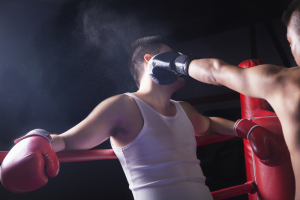Trauma causing dementia can develop when the brain is jarred from a blow to the head and a head concussion results from this. A number of such injuries over a period of time can leave the person with micro-scars in the brain that seriously affect the brain’s function. Two types of consequences can result from head trauma:
A) Repeat trauma to the frontal lobes of the brain such as in boxers leads to the frontal lobe dementia syndrome. Here we are talking about direct damage of the brain cells in the area where the force of the impact was highest.
B) Another presentation following head trauma is the normal pressure hydrocephalus. The flow of cerebrospinal fluid within and around the brain is blocked from microtrauma to the structures along the pathway of this fluid. This leads to three major symptom complexes (also called a “triad”), namely a dementia, an insecure gait with the feet placed far apart and involuntary urine loss are typically associated.
The neurologist will organize a CT scan which shows dilatation of the ventricles. A lumbar puncture needle in the back will show a high-normal pressure of the cerebrospinal fluid, which is bathing the brain and the spinal cord. When a certain portion of the cerebrospinal fluid is taken off and the patient suddenly improves with the symptoms, a shunt placed permanently will often cure the problem.
References:
1. OL Lopez et al. Neurology 2000 Dec 55(12):1863-1869.
2. K Yasojima et al. Brain Res 2000 DEC 887(1):80-89.
3. A Kontush et al. FreeRadicBiol Med2001Jan30(1): 119-128.
4. H Vanderstichele et al. Amyloid 2000Dec7(4):245-258.
5. Neely et al. Lipids 2000 Nov35(11):1249-1257.
6. RA Yokel Neurotoxicology 2000 Oct21(5):813-828.
7. Petanceska et al. Exp Gerontol 2000 Dec 35 (9-10):1317-1325.
8. MB Liddell et al. Brit J Psychiatry 2001 Jan 178: 7-11.
9. Sramek et al.ExpertOpinInvestigDrugs2000Apr9(4):899-915.
10.K Kosaka et al. Neuropathology 2000 March 20(1): 1-7.
11.V Haroutunian et al.Arch Neurol 2000 Aug57(8):1145-1150.
12. C Puckett et al. Am J Hum Genet 1991Aug49(2):320-329.
13. M Haltia Ann Med 2000 Oct 32(7): 439-500.
14. Ferri: Ferri’s Clinical Advisor: Instant Diagnosis and Treatment, 2004 ed., Copyright © 2004 Mosby, Inc.
15. Rakel: Conn’s Current Therapy 2004, 56th ed., Copyright © 2004 Elsevier







